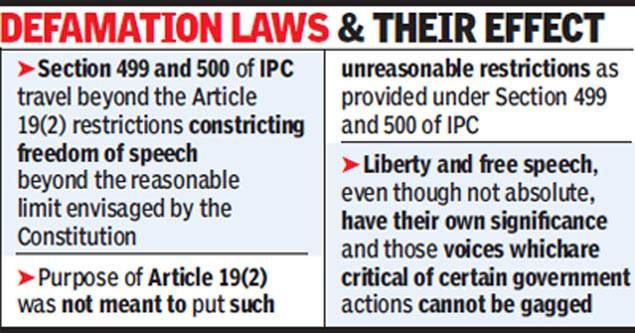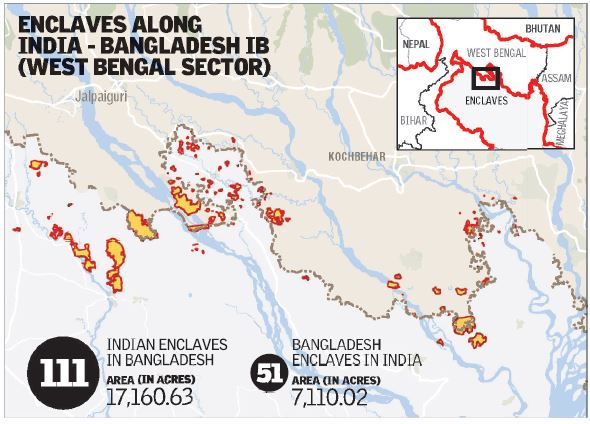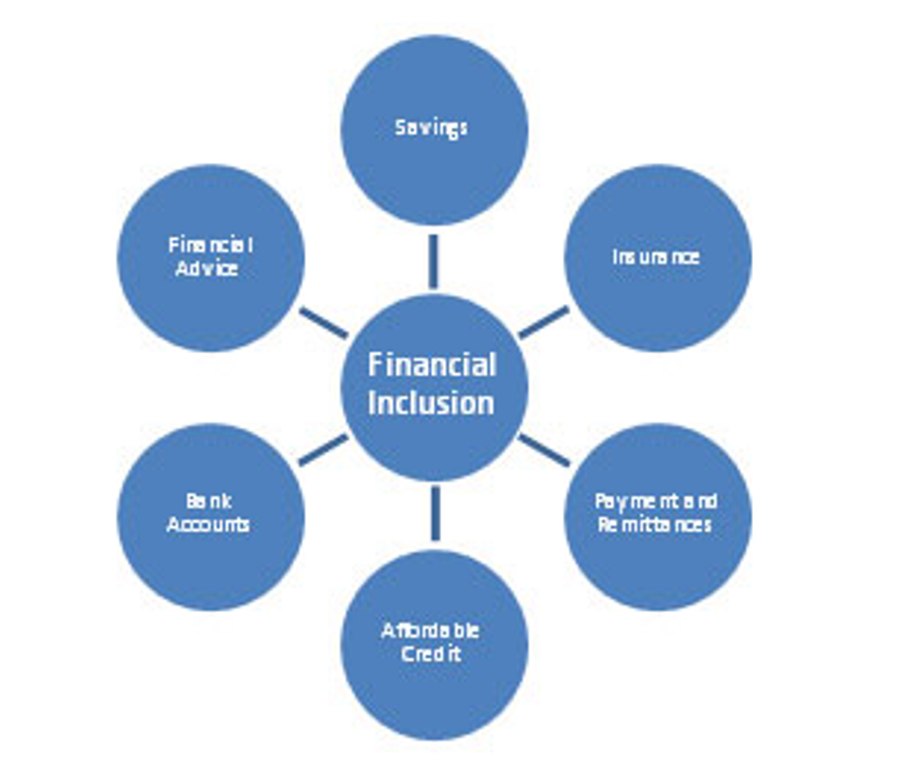IASbaba's Daily Current Affairs Analysis, IASbaba's Daily Current Affairs July 2015, International, National, UPSC
Archives
IASbaba’s Daily Current Affairs- 16th July, 2015
NATIONAL
Criminal defamation- A pernicious law
- The United Nations Special Rapporteur on freedom of expression, the Human Rights Committee of the International Covenant on Civil and Political Rights and other international bodies have called upon states to abolish criminal defamation, recognizing that it intimidates citizens and dissuades them from exposing wrongdoing.

What is there in the Indian Penal Code?
- The grounds cited by the Centre now to justify the continuance of Sections 499 and 500 of the IPC, which deal with defamation and prescribe a maximum jail term of two years, are specious
- That in India, citizens are unlikely to have enough liquidity to pay damages for civil defamation;
- That online defamation in the Internet age can be effectively countered only by making it a criminal offence, and that the law is part of the state’s “compelling interest” to protect the dignity and reputation of citizens.
What is the ugly side of Criminal defamation?
- It fails to see is that the main feature of criminal defamation is its potential for harassment.
- It is a tool that can be easily invoked and that enables allegedly defamed persons to drag anyone to courts across the country.
- Criminal defamation has a pernicious effect on society.
How is the state using this?
- The state uses it as a means to coerce the media and political opponents into adopting self-censorship and unwarranted self-restraint; groups or sections claiming to have been hurt or insulted, abuse the process by initiating multiple proceedings in different places; and, more importantly, the protracted process itself is a punishment.
Connecting the Dots:
- Write a note on how Defamation works in a democratic country like India.
- Should Indian government come out against the criminal defamation law?
- Is criminal defamation invoked to stifle free speech?
India can be world’s HR capital: PM
- Prime Minister Narendra Modi has pitched for making India a ‘human resource capital’ of the world like China has become a ‘manufacturing factory’ as he launched a number of schemes to train 40 crore people in various skills by 2022 as part of ‘war against poverty’.
- Skill developmentis the shared responsibility of the key stakeholders viz. Government, the entire spectrum of corporate sector, community based organizations, those outstanding, highly qualified and dedicated individuals who have been working in the skilling and entrepreneurship space for many years, industry and trade organisations and other stakeholders
- India has the potential to provide a workforce of about 4-5 crore to the world if the capabilities of the countrymen are honed through proper and dynamic skill training.
- The ambitious schemes launched by the PM were National Skill Development Mission, the National Policy for Skill Development and Entrepreneurship 2015, Pradhan Mantri Kaushal Vikas Yojana and Skill Loan scheme on World Youth Skill Day.
More about National Skill Development Mission
The National Skill Development Mission consists of following three institutions:
- The Prime Minister’s National Council on Skill Development (NCSD) -under the chairmanship of PM, for policy direction and review of spectrum of skill development efforts in country.
- National Skill Development Coordination Board (NSDCB)-under the chairmanship of Dy. Chairman Planning Commission to enumerate strategies to implement the decisions of PM’s council.
- National Skill Development Corporation (NSDC), a non-profit company under the Companies Act, 1956. The corporation is being funded by trust “National Skill Development Fund
Objective:
- The objective of NSDC is to skill/upskill 150 million people in India including persons from rural areas by the year 2022, mainly by fostering private sector initiatives in skill development programmes and providing viability gap funding.
- NSDC would cover skills from the organized as well as from the un-organized sector.
National Policy for Skill Development and Entrepreneurship 2015
National Policy for Skill Development and Entrepreneurship 2015 supersedes the policy of 2009.
Objective:
- The objective will be to meet the challenge of skilling at scale with speed and standard (quality). It will aim to provide an umbrella framework to all skilling activities being carried out within the country, to align them to common standards and link the skilling with demand centres.
- In addition to laying down the objectives and expected outcomes, the effort will also be to identify the various institutional frameworks which can act as the vehicle to reach the expected outcomes.
- The policy links skills development to improved employability and productivity in paving the way forward for inclusive growth in the country.
Pradhan Mantri Kaushal Vikas Yojana
- Pradhan Mantri Kaushal Vikas Yojana is a unique initiative by the Government of India that aims to offer 24 lakh Indian youth meaningful, industry relevant, skill based training making every skilled youth employable.
- Under this scheme, the trainees will be offered a financial reward and a government certification on successful completion of training and assessment, which will help them in securing a job for a better future.
Skill Loan scheme
- Under the scheme loans ranging from Rs 5,000-1.5 lakhs will be made available to 34 lakh youth of India seeking to attend skill development programmes over the next five years.
Courtesy- http://pib.nic.in/
Connecting the Dots:
- Do you think India can become a ‘Human Resource Capital’?
- In the present scenario, what are the challenges faced by India in the area of Skill Development? How can we overcome these challenges?
- Can the same approach be applied to both organized and unorganized sector for Skill Development?
INTERNATIONAL
90% of enclave dwellers give choice of nation
- India and Bangladesh will complete a survey asking each of the 51,000 people living in 162 enclaves on the border to give their choice of citizenship of either nation.
- Most Bangladeshi nationals on the Indian side wanted to remain in India, the decision of Indians on the Bangladeshi side would depend on the compensation offered for their lands.

What is Indo-Bangla Enclave Exchange Coordination Committee about?
- Indo-Bangla Enclave Exchange Coordination Committee is appointed to submit a rehabilitation plan for the dwellers of Indian enclaves in Bangladesh who want to settle in India after the land boundary agreement has been implemented.
- The committee is expected to submit a list of 149 families who want to settle in India with a rehabilitation plan to look after their stay.
- India and Bangladesh governments had signed the enclave exchange protocol in September 2011.
Why Enclave Exchange Protocol?
- An international enclave is a fragment of foreign territory landlocked within a country.
- When the borders were drawn in 1947, about 51 international enclaves came into being in India, initially territories of East Pakistan and then of Bangladesh.
- There are 111 Indian enclaves in Bangladesh.
- Over the last six decades, enclave dwellers have led a stateless existence, stranded in these tiny pockets of land.
Are they the people without a state?
- Cut off from the administrative offices of their country’s mainland, they cannot acquire birth certificates or passports.
- Accessing basic facilities like hospitals and primary schools, or going to nearby markets to make a living, entails a perilous journey across an international border and harassment by state officials.
- Until a joint census conducted by the two countries in 2011, they were never counted.
Whatprovided for the exchange of enclaves between the two countries?
- Prime Minister Manmohan Singh and his Bangladeshi counterpart signed the Land Boundary Agreement (LBA), which provided for the exchange of enclaves between the two countries.
- But that initiative lost its way in Parliament.
- Apart from the need to keep faith with a loyal ally, the plight of the enclave dwellers should be a powerful argument for pressing on with the land swap deal.
Connecting the Dots:
- Write a note on the Enclave Dwellers who live in a stateless limbo?
- Write a note on the Land Boundary Agreement and Teesta Treaty.
ECONOMICS
RBI sets up panel on financial inclusion
RBI has set up a committee on Financial Inclusion under the chairmanship of Deepak Mohanty, Executive Director of RBI.
What would the Panel work upon?
- The panel would suggest a `monitorable’ medium-term action plan for financial inclusion in terms of its various components such as payments, deposit, credit, social security transfers, pension and insurance.
- The committee would review the existing policy of financial inclusion, including supportive payment system and customer protection framework.
- It would also study cross-country experiences in financial inclusion to identify key learning, particularly in the area of technology-based delivery models.
With regard to Rural Inclusion :
- It would look into group-based credit delivery mechanisms
- Consumer protection and financial literacy
- Delivery mechanism of financial inclusion encompassing both households and small businesses.
Courtesy – Image – http://www.arthapedia.in/images/6/66/Financial-inclusion.jpg
More about Financial Inclusion
- Financial inclusion is the delivery of financial services at affordable costs to vast sections of disadvantaged and low income groups (For example: no frill accounts)
Connecting the Dots:
- Why Financial Inclusion is important in our country?
- What are the steps taken by Government of India and RBI in this regard?














